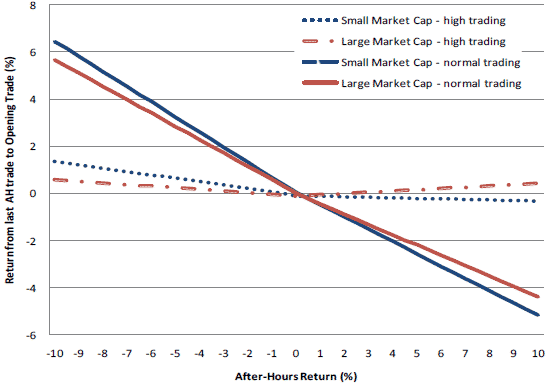Can traders reliably turn a profit by providing liquidity to anxious after-hours counterparts and then closing the trade at the open? In his September 2009 paper entitled “The Cost of Illiquidity: Evidence from After-Hours Trading”, Brian Walkup quantifies price reversal/momentum when the market opens for stocks experiencing price movements during preceding after-hours trading. Using a large sample of after-hours trades from the three major U.S. stock exchanges during 2006, he concludes that:
- If after-hours trading for a stock is within its normal range (number of trades no more than two standard deviations above average), then on average about 40%-65% of the after-hours price change reverses immediately at the open of regular trading.
- The reversal for small market capitalization stocks is on average about 7.7% larger than that for large capitalization stocks.
- The reversal is on average about 6.6% larger across weekends than non-weekends.
- The reversal for negative after-hours returns is on average about 12% larger (56% versus 44%) than that for positive after-hours returns, perhaps indicating that after-hours “must-sell” motivation is stronger than “must-buy” motivation.
- Reversal persists after the open as trading picks up throughout the morning.
- However, when after-hours volume for a stock is very high (likely because of news about the firm), the reversal at the open shrinks considerably, even becoming a continuation.
The following chart, taken from the paper, relates reversal at the next open to preceding after-hour return for the sample used in the study. The principal determinant of reversal is whether or not there is large number of trades (more than two standard deviations above its average). If trading activity is normal, a substantial fraction of the after-hours price change reverses immediately at the open of regular trading. Approximately 40%-65% of normal after-hours price movement is thus attributable to a liquidity premium. When there is news about a firm, after-hours volume spikes and liquidity becomes less of an issue, and the reversal effect nearly disappears.

In summary, evidence indicates that traders can reliably earn a material premium by providing liquidity for after-hours trading of U.S. stocks and closing these trades at the next market open, so long as the after-hours trading in the stocks is not abnormally active.